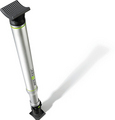Audi's turbodiesel, electric flywheel hybrid, all-wheel drive prototype race car
by: Gizmag Emerging Technology Magazine, 2012-03-15 09:40:44 UTC

Audi's newly revealed R18 e-tron quattro race car is designed to win the 2012 Le Mans 24 Hour Race. Whatsmore, the turbodiesel, electric flywheel hybrid, all-wheel drive prototype will ensure the 2012 race will be a battle of the hybrids (against Toyota's new TS030 ultracapacitor hybrid race car), and a fascinating study of new technologies under race conditions. The car uses electric motors to add 75 kW (102 bhp) of power to each front wheel, and a 375 kW (510 bhp) V6 TDI engine powers the rear wheels. The Williams Hybrid Power electric flywheel hybrid captures energy similarly to the unit Porsche used to such great effect in its GT3 R Hybrid last year with the rear axle powered conventionally, and the front wheels by electric motors. Audi calls it "the electrification of the drive" and it will be a story worth following as battle begins on the racetrack...
Continue Reading
Audi's turbodiesel, electric flywheel hybrid, all-wheel drive prototype race carSection: AutomotiveTags: Audi,
Automotive,
BMW,
Diesel,
Hybrid,
Le Mans,
Porsche,
Toyota,
Volkswagen
Related Articles:


 Best of Green Readers' Choice: Design
Best of Green Readers' Choice: Design
by: TreeHugger Design, 2012-03-16 08:00:40 UTC

What's the cutest tiny shed or building, best single family house, or best new furniture design? Vote on these and more.
5 Marketplace Trends That Will Shape the Green Economy and Change Brands
by: Environmental Leader, 2012-03-16 10:24:32 UTC

The dawn of a more resourceful, creative and sustainable economy is beginning, with a growing number of New Consumers re-thinking what really matters and creating new ways to do more with less. BBMG’s Raphael Bemporad and Mitch Baranowski introduce you to these values-aspirational, practical purchasers and share five emblematic trends that show how this group [...]
 Money Loss Calculators ‘Key’ to Halting Energy Waste
Money Loss Calculators ‘Key’ to Halting Energy Waste
by: Environmental Leader, 2012-03-16 14:15:22 UTC

Adding calculated energy efficiency measurements or “money loss” calculators to plant equipment such as furnaces is a great way of alerting factory operators to energy loss, according to SustainablePlant.com. Money loss calculators are software programs that, when used on a furnace, measure such variables as oxygen, draft and fuel usage and analyze the info to [...]
 Unilever, BT, 13 Others Top Corporate Responsibility Index
Unilever, BT, 13 Others Top Corporate Responsibility Index
by: Environmental Leader, 2012-03-16 14:30:09 UTC

KPMG, Unilever, EDF Energy, BT Group, Heineken UK, Marks & Spencer, PwC, J Sainsbury and seven other companies earned the Platinum Plus rating for corporate responsibility, retaining their status from last year, in rankings from U.K. non-profit Business in the Community. Platinum rankings, for scores of 95 percent and up, were earned by 42 companies [...]
 USGBC LEED Green Building Program to Recognize Energy Credits from BREEAM
USGBC LEED Green Building Program to Recognize Energy Credits from BREEAM
by: Sustainable Design News, 2012-03-16 23:12:57 UTC
 A pivotal LEED International Roundtable meeting of European roundtable members ended in Paris today. The meeting convened leaders from across Europe to address regional issues in LEED for existing and historic structures in the E.U.
A pivotal LEED International Roundtable meeting of European roundtable members ended in Paris today. The meeting convened leaders from across Europe to address regional issues in LEED for existing and historic structures in the E.U.
At the meeting it was announced that the U.S. Green Building Council's (USGBC) LEED green building program will now recognize credits from BREEAM, the U.K.'s widely used green rating program.
 pine needle shoes by hadas ilani
pine needle shoes by hadas ilani
by: Designboom - Weblog, 2012-03-16 11:21:00 UTC

an experiment on the use of local material, different sewing techniques were applied to pine needles, creating a textile which is then formed into shoes.
read more
13 Percent of Americans Say They’d Likely Install an Energy Dashboard
by: Greentech Media: Headlines, 2012-03-16 16:45:23 UTC
Education, education, education. It’s a common refrain in smart grid circles around the issue of how to bring consumers along as utilities invest in smart grid using ratepayers’ money.
But when it comes to basic energy efficiency upgrades, a recent Harris poll found that Americans are still largely apathetic to making changes in their energy use. Whether that is from a lack of knowledge, time, interest or willingness, utilities have a long way to go.
Only 13 percent said they were very likely to install an energy dashboard to monitor home energy use. Another 35 percent said they were somewhat likely to do so, showing that there could be a willingness but that’s still less than half of the 2,056 people polled in an online survey.
Of course, the question leads to other questions. What does “install” mean? Is that turning something on, or is it an actual installation, like a do-it-yourself smart thermostat?
On the subject of smart thermostats, less than half of those polled, 37 percent have installed a programmable thermostat. Not that it matters, since the percentage of those who correctly use their programmable thermostats is far lower than that.
New technology could help change those numbers. From the media [not this media - ed.] darling Nest thermostat, to the fully automated EcoFactor software-as-service, there are increasing alternatives in the marketplace that are far more functional than the first generation of programmable thermostats.
In many ways, the questions were not designed to extrapolate meaningful interaction. One question asked participants: "If you were allotted a maximum amount of energy for daily use that varies during peak energy usage periods, would you prefer to manage that energy distribution yourself (assuming appliance use and time of day use) or would you prefer to have your utility cycle appliance use to keep you in compliance?"
Unsurprisingly, nearly 70 percent of participants said they would prefer to manage their own energy use, and only about 10 percent would prefer to have the utility manage it.
Of course people don't want a utility to have carte blanche in their homes. Instead of taking the control from the homeowner, most critical peak pricing programs for residents will almost surely be voluntary for individuals in the forseeable future. There simply isn’t the technology available in most homes today for a utility to cost-effectively go off turning off lights and computers. As for HVAC, there are various technologies that allow people to enroll in demand response while still maintaining some degree of control. Maybe you allow the utility to turn your AC up a few degrees, but not 10.
Other upgrades are obviously driven by utility incentives and legislative mandates. Forty percent of people in the water-constrained West have installed low-flow faucets, compared to just a quarter in the East and Midwest.
Only about one in 10 Americans had done a whole home energy audit, which is also not surprising given the fragmented retrofit space and the lack of knowledge about what’s available in terms of government and utility incentives. Recurve, which was trying to serve the residential retrofit market, was recently sold to Tendril because of the slow uptake for its product.
Many of the answers show that the role utilities play, both in how they present options to customers and the incentives for participation, are critical in uptake.
Another recent survey by the American Council for an Energy-Efficient Economy found that utilities’ energy efficiency programs can yield huge savings, or absolutely none at all. The secret sauce is not necessarily real-time or not, but how engaged customers are when they enroll and how much carrot vs. stick was presented.
Savvy utilities are taking notes. Oklahoma Gas & Electric, which will roll out Silver Spring’s CustomerIQ portal and Energate smart thermostats to 150,000 customers over the next few years are just digging into exactly which customers those should be. Some will be homes with high loads, such as pools, but the utility is also looking for a broad swath of the customer base to participate.
It’s a fine balance, and one that requires utilities to start by segmenting their customer base to better understand who will target, and be enticed, by energy efficiency programs. Although education campaigns around smart grid and efficiency have been going on for some years, segmentation seems to be a trend that has only settled in with some of the more progressive utilities in the past year. It is a slow process, as any new program tends to be with utilities, and it could be years before segmentation gets broad uptake to push efficiency into the mainstream.
Smart Grid Has Its Head in the Cloud
by: Greentech Media: Headlines, 2012-03-15 16:15:02 UTC
The cloud is everywhere in the business world, and it’s no different for utilities and companies making energy efficiency upgrades. From building management systems to home energy systems to meter data management, cloud-computing platforms have started to become a dominant force in smart grid in the past year.
To meet the needs of utilities that want well-integrated back-office software at a price they can afford, nearly every company is putting up a cloud offering.
Early last year, Verizon announced a partnership with eMeter to offer cloud-based meter data management for utilities. The service leverages Verizon’s IP network to deliver scalable meter data management. The partnership with Verizon is a strategic decision to make it easier for utilities to jump into managing their data without the huge upfront capital costs.
Ecologic Analytics, which was snapped up by Landis+Gyr earlier this year, has a hosting service, while Itron is working with IBM, SAP and Teradata to set up a meter data warehousing and analytics system for Southern California Edison. Aclara, which controls many of the consumer engagement sites for utilities, has also long been using the cloud.
Although a system hosted in the cloud could offer greater flexibility for large utilities such as SCE, it is also a chance for the munis and co-ops to get more robust MDM offerings at a lower cost.
For utilities, the savings can be significant. Hardware has typically been the bulk of project cost in the past, but Palo Alto found that the meter data management cost was estimated at 40 percent of the AMI implementation, or about $6 million total.
Nearly every smart grid vendor has said that the muni and co-op market is a focus for 2012, now that the stimulus funds have all been doled out and very large investor-owned-utility smart grid contracts are few and far between.
Winning the smaller markets means having a price point that the lean utilities can absorb and see value from almost immediately. For many, that means a cloud application for back-end systems.
Cloud computing is also being sold, especially to smaller utilities, for a range of other applications, such as distribution automation and demand response.
Lockheed Martin has integrated its demand response capabilities in a cloud platform specifically for the co-op market. General Electric has taken it a step further in a project with Norcross, GA to do various distribution automation services via the cloud.
Proximetry, which works with Cisco, also offers a cloud-based network management service for utilities to manage the whole of their communications networks, which could cover the distribution side.
Cloud applications are increasingly popular for in-house and DA applications, but they are arguably even more popular for consumer-facing energy platforms, and not just customer web portals.
There is hardly a home energy management vendor that does not host some, or all, of their data in the cloud. EcoFactor, Opower, Tendril, PassivSystems, ThinkEco, Honeywell, and EnergyHub are just a few of the names that leverage the cloud to deliver everything from HVAC management and utility alerts to solar PV monitoring and EV charging updates.
With the cloud, however, comes great responsibility. Consumers are not only concerned with what the utility is doing with their data, but are also anxious about who else could hack into it. Opower, which is teamed up with Honeywell for cloud-connected thermostats, released its own set of data principles around access, transparency and security of the information with which the company has been entrusted.
Although many consumers have no problem banking or managing their personal and business email using cloud computing, the question of security when it comes to energy information is often raised. As the cloud becomes ubiquitous in smart grid, others will likely publish very clear data principles similar to those developed by Opower to reassure customers about how their information is being stored. Other companies, like FutureDash, are trying to distinguish themselves by talking about security provisions that protect information going up to the cloud.
Homeowners will also likely use the cloud for more than just energy. Lowe's launched its Iris platform earlier this year, which will use the cloud for an entire connected home, from security to energy to comfort.
The individual homeowner is just one part of the consumer-facing proposition of cloud-based energy services. Building management is also increasingly moving to the cloud, a trend that could increase the availability for medium and small commercial, which, like munis and co-ops, do not have deep enough pockets or the need for some of the more full-fledged building management systems. From big legacy companies like Siemens and Honeywell to startups like SCIEnergy, nearly every building management has, or is moving toward, a cloud-based solution for owners.
To hear more about how the cloud is being leveraged in smart grid, join Greentech Media in Raleigh-Durham on April 4-5 for The Networked Grid, where we will dive into the role of cloud-based services for utilities and energy efficiency.
Nokia Lumia 610 can double as Wi-Fi hot spot
by: Crave Green tech, 2012-03-16 16:34:49 UTC
Nokia's Lumia 610 offers Wi-Fi tethering out of the box.
(Credit:
Kent German/CNET)
Owners of Nokia's Lumia 610 can use their phone as a hot spot to provide Wi-Fi coverage for up to five different devices.
Nokia's Lumia 610 Web site specifically lists that feature under the Sharing and Internet category. The feature pages for the Lumia 710 and the 800 don't yet make any mention of hot-spot capability.
But sit tight, Lumia owners. A Nokia spokesman confirmed to CNET that the company will add hot-spot functionality to the 710 and 800 in a future software update.
Nokia's Web site doesn't yet provide details on the Lumia 900, which is expected to debut in the U.S. on April 22 through AT&T. But the 900 will also offer built-in hot-spot access for up to five devices. A Nokia product manager confirmed that news in January, explaining that the 900 will come with Wi-Fi tethering out of the box with the... [Read more]
Related Links:
Nokia likely to unveil Lumia 610 and 900 phones next week
Nokia fills out Lumia portfolio, highlights exclusive services
Nokia Lumia 800 pops up unlocked at Microsoft stores
More Nokia Lumia 610 details leak
Nokia Lumia 900 launch pushed back until April 22?










Comments by our Users
Be the first to write a comment for this item.